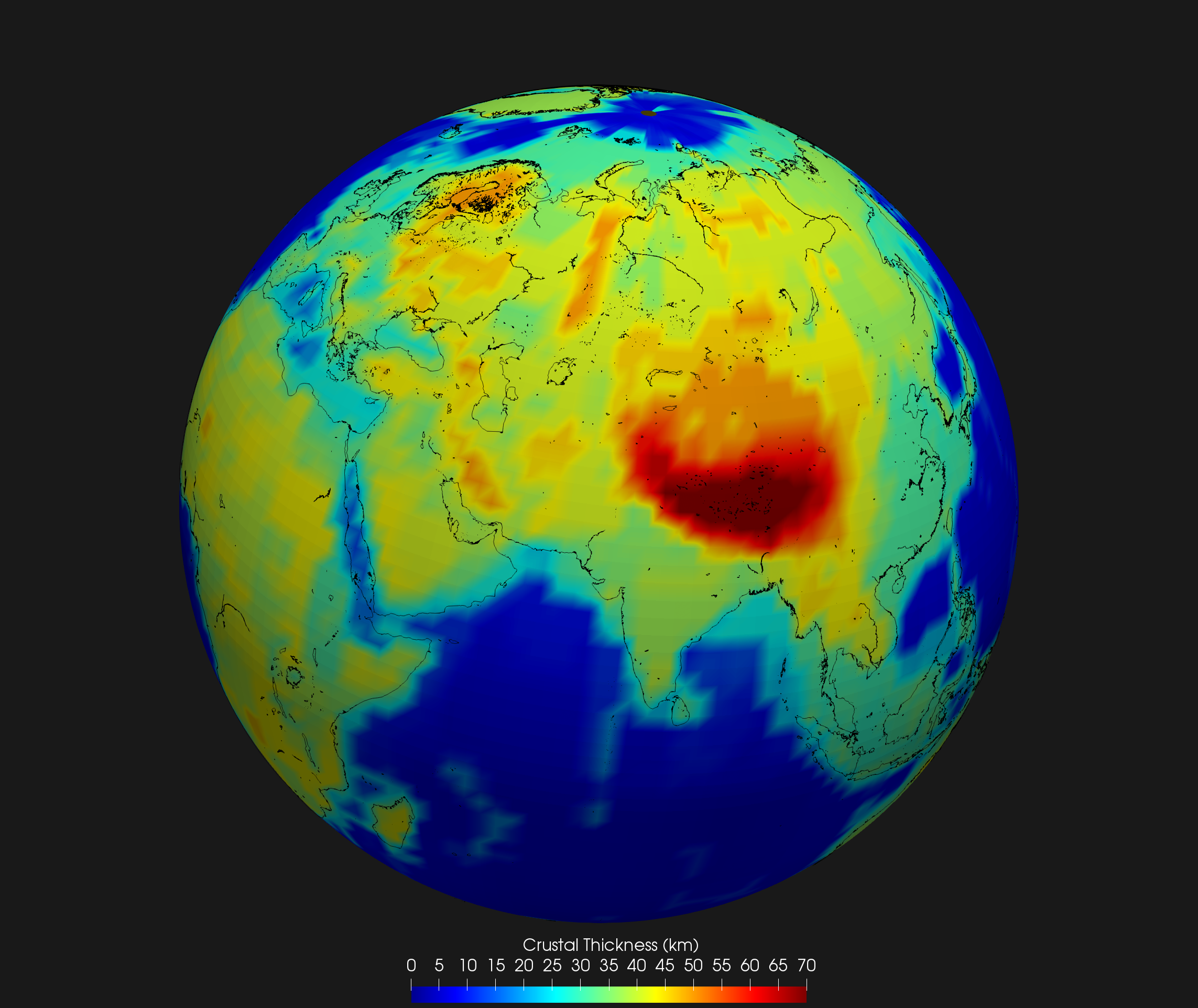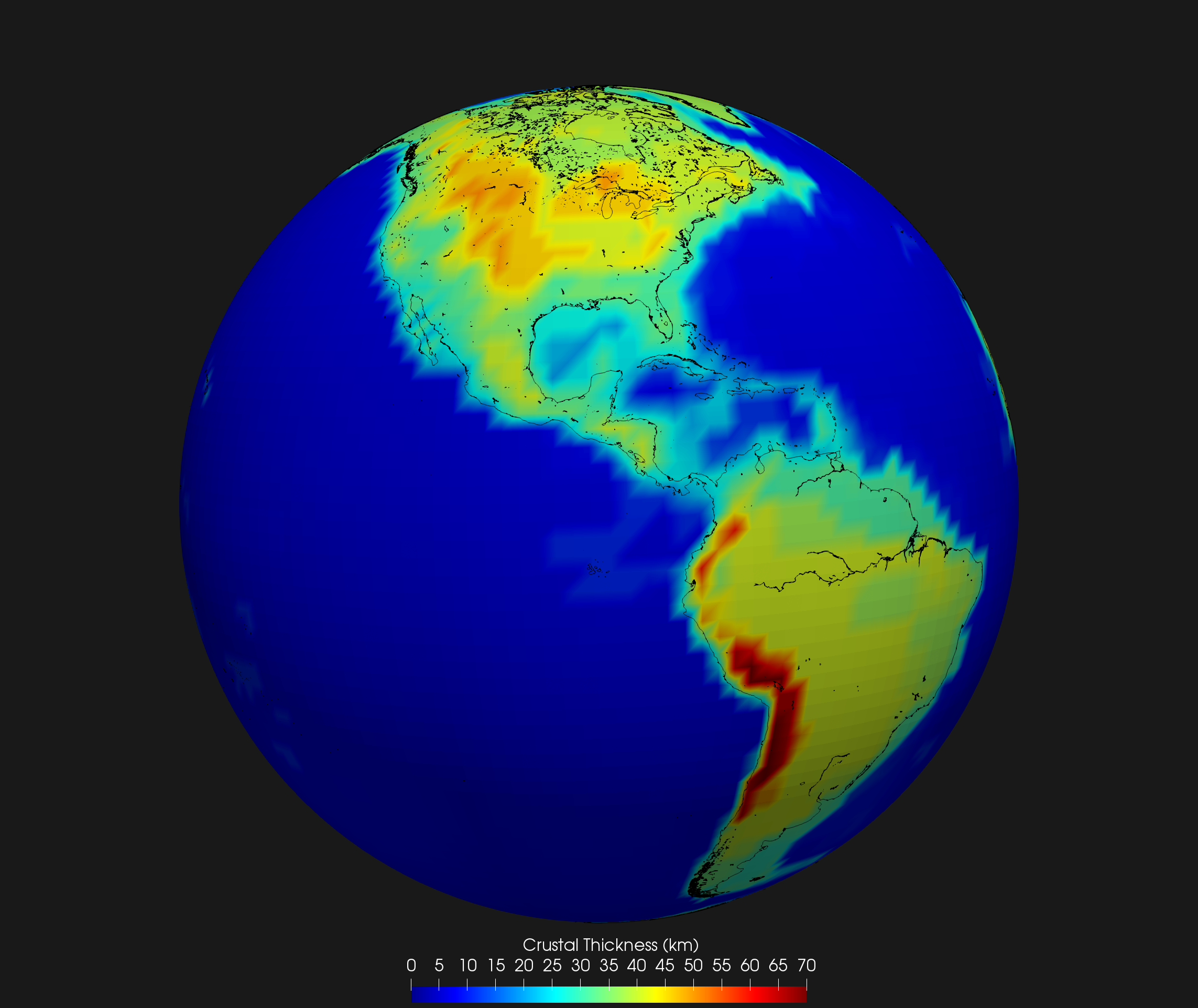Summary
CRUST2.0 (Bassin, Laske, & Masters, 2000) is a global crustal model specified on a 2°-by-2° grid and incorporates the global sediment thickness.
Note: This model is superseded by the higher-resolution crustal model CRUST1.0. Authors discourage the usage of this model.
Quicklinks
Description
| Name | CRUST2.0 |
| Title | A 2-by-2 Degree Global Model of Earth’s Crust |
| Type | Crustal Earth Model |
| Sub Type | Crustal profile |
| Year | 2000 |
| Data Revision | r0.0 (revision history) |
| Short Description |
The CRUST 2.0 is an updated version of CRUST 5.1 (Mooney, Laske and Masters, 1998). This model is specified on a 2×2 degree grid and takes advantage of a compilation of global sediment thickness which is defined on a 1×1 degree grid. Also, the ice thickness is compiled on the same scale. The compilation used for this model covers most of Eurasia, North America, Australia and some areas of Africa and South America and in the oceans. The original global crustal models CRUST 5.1 and CRUST2.0 use type keys to assign various types of crustal structure (such as Archean, early Proterozoic, rifts etc.) in each cell. Starting with CRUST5.1, cells in CRUST2.0 were adjusted in type to better reflect the edges of shelves and the coastline. Adjustments have been made in some tectonic regions in the Americas and Eurasia (especially around the orogenic belts). Adjustments to the ice thickness were also made in each cell and is now within 250m of the true ice thickness. Sediment thicknesses in each cell are to within 1.0 km of the true sediment thickness and crustal thickness are within 5 km of the true crustal thickness. Bathymetry and topography is that of ETOPO5. The 2×2 degree model is composed of 360 key 1d-profiles (compared to 139 of CRUST5.1) where one of these profiles is assigned to each 2 × 2 degree cell. Each individual profile is a 7 layer 1D-model with 1. ice 2. water 3. soft sediments 4. hard sediments 5. upper crust 6. middle crust 7. lower crust Parameters VP, VS and rho are given explicitly for these 7 layers as well as the mantle below the Moho. The variable names in the netCDF version of the CRUSt2.0 model are based on the above seven layers (see the model metadata for a complete list of the variables). |
| Usage Notes | Authors discourage the usage of this model. Users are encouraged to use the CRUST1.0 model. Each layer in this model is represented as a single 2D variable (for example, see the CRUST2.0.nc metadata). The values are cell-based and evaluated at the cell centers (model variables are defined tile by tile with the geographical coordinates referring to the center of tile). |
| Authors: | Gabi Laske, IGPP, Scripps Institution of Oceanography, U.C. San Diego, La Jolla, CA, USA Guy Masters, IGPP, Scripps Institution of Oceanography, U.C. San Diego, La Jolla, CA, USA Christine Reif, Department of Earth Sciences, Institute of Geophysics and Planetary Physics, University of California, Santa Cruz, Santa Cruz, CA 95064 |
| Base Model | CRUST5.1 |
| Referenced by | SALSA3D, CRUST1.0 |
| Model Download | |
| CRUST2.0.r0.0.nc is the netCDF file for the above model (see the model metadata for a complete list of the variables). | |
| Model Homepage | https://igppweb.ucsd.edu/~gabi/crust2.html |
| Depth Coverage | 0 km to the Moho depth |
| Area | Global |


Citations and DOIs
To cite the original work behind this Earth model:
- Bassin, C., Laske, G. and Masters, G., The Current Limits of Resolution for Surface Wave Tomography in North America, EOS Trans AGU, 81, F897, 2000.
To cite IRIS DMC Data Products effort:
- Trabant, C., A. R. Hutko, M. Bahavar, R. Karstens, T. Ahern, and R. Aster (2012), Data Products at the IRIS DMC: Stepping Stones for Research and Other Applications, Seismological Research Letters, 83(5), 846–854, https://doi.org/10.1785/0220120032.
DOI for this EMC webpage:
Reference
- A description of CRUST 5.1 can be found in: Mooney, Laske and Masters, CRUST 5.1: a global crustal model at 5×5 degrees, JGR, 103, 727-747, 1998.
Credits
- r0.0 Model provided by Gabi Laske.
Revision History
revision r0.0: uploaded December 13, 2021.






